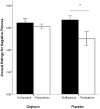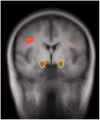Amygdala response to negative images in postpartum vs nulliparous women and intranasal oxytocin
- PMID: 22956670
- PMCID: PMC3871727
- DOI: 10.1093/scan/nss100
Amygdala response to negative images in postpartum vs nulliparous women and intranasal oxytocin
Abstract
The neuroendocrine state of new mothers may alter their neural processing of stressors in the environment through modulatory actions of oxytocin on the limbic system. We predicted that amygdala sensitivity to negatively arousing stimuli would be suppressed in postpartum compared to nulliparous women and that this suppression would be modulated by administration of oxytocin nasal spray. We measured brain activation (fMRI) and subjective arousal in response to negatively arousing pictures in 29 postpartum and 30 nulliparous women who received either oxytocin nasal spray or placebo before scanning. Pre- and post-exposure urinary cortisol levels were also measured. Postpartum women (placebo) demonstrated lower right amygdala activation in response to negative images, lower cortisol and lower negative photo arousal ratings to nulliparous women. Nulliparous women receiving oxytocin had lower right amygdala activation compared to placebo. Cortisol levels in the placebo group, and ratings of arousal across all women, were positively associated with right amygdala activation. Together, these findings demonstrate reductions in both amygdala activation and subjective negative arousal in untreated postpartum vs nulliparous women, supporting the hypothesis of an attenuated neural response to arousing stimuli in postpartum women. A causal role of oxytocin and the timing of potential effects require future investigation.
Keywords: amygdale; arousal; cortisol; oxytocin; postpartum.
Figures





Similar articles
-
Oxytocin increases VTA activation to infant and sexual stimuli in nulliparous and postpartum women.Horm Behav. 2015 Mar;69:82-8. doi: 10.1016/j.yhbeh.2014.12.009. Epub 2015 Jan 3. Horm Behav. 2015. PMID: 25562711 Free PMC article. Clinical Trial.
-
Lower sexual interest in postpartum women: relationship to amygdala activation and intranasal oxytocin.Horm Behav. 2013 Jan;63(1):114-21. doi: 10.1016/j.yhbeh.2012.10.007. Epub 2012 Oct 18. Horm Behav. 2013. PMID: 23085496 Free PMC article.
-
Neural correlates of emotion processing comparing antidepressants and exogenous oxytocin in postpartum depressed women: An exploratory study.PLoS One. 2019 May 31;14(5):e0217764. doi: 10.1371/journal.pone.0217764. eCollection 2019. PLoS One. 2019. PMID: 31150502 Free PMC article.
-
No laughing matter: intranasal oxytocin administration changes functional brain connectivity during exposure to infant laughter.Neuropsychopharmacology. 2012 Apr;37(5):1257-66. doi: 10.1038/npp.2011.313. Epub 2011 Dec 21. Neuropsychopharmacology. 2012. PMID: 22189289 Free PMC article. Clinical Trial.
-
Low-dose intranasal oxytocin delivered with Breath Powered device modulates pupil diameter and amygdala activity: a randomized controlled pupillometry and fMRI study.Neuropsychopharmacology. 2019 Jan;44(2):306-313. doi: 10.1038/s41386-018-0241-3. Epub 2018 Oct 16. Neuropsychopharmacology. 2019. PMID: 30323359 Free PMC article. Clinical Trial.
Cited by
-
The maternal brain and its plasticity in humans.Horm Behav. 2016 Jan;77:113-23. doi: 10.1016/j.yhbeh.2015.08.001. Epub 2015 Aug 9. Horm Behav. 2016. PMID: 26268151 Free PMC article. Review.
-
Sex, receptors, and attachment: a review of individual factors influencing response to oxytocin.Front Neurosci. 2013 Jan 10;6:194. doi: 10.3389/fnins.2012.00194. eCollection 2012. Front Neurosci. 2013. PMID: 23335876 Free PMC article.
-
The oxytocinergic system in PTSD following traumatic childbirth: endogenous and exogenous oxytocin in the peripartum period.Arch Womens Ment Health. 2020 Jun;23(3):317-329. doi: 10.1007/s00737-019-00994-0. Epub 2019 Aug 6. Arch Womens Ment Health. 2020. PMID: 31385103 Free PMC article. Review.
-
Intranasal Oxytocin Increases Perceptual Salience of Faces in the Absence of Awareness.Psychiatry Investig. 2020 Apr;17(4):292-298. doi: 10.30773/pi.2019.0130. Epub 2020 Mar 24. Psychiatry Investig. 2020. PMID: 32200608 Free PMC article.
-
Oxytocin increases VTA activation to infant and sexual stimuli in nulliparous and postpartum women.Horm Behav. 2015 Mar;69:82-8. doi: 10.1016/j.yhbeh.2014.12.009. Epub 2015 Jan 3. Horm Behav. 2015. PMID: 25562711 Free PMC article. Clinical Trial.
References
-
- Altemus M. Neuropeptides in anxiety disorders—effects of lactation. Annals of the New York Academy of Sciences. 1995;771:697–707. - PubMed
-
- Altemus M, Redwine LS, Leong Y, Frye CA, Porges SW, Carter SC. Responses to laboratory psychosocial stress in postpartum women. Psychosomatic Medicine. 2001;63:814–21. - PubMed
-
- Bartz JA, Hollander E. The neuroscience of affiliation: forging links between basic and clinical research on neuropeptides and social behavior. Hormones and Behavior. 2006;50:518–28. - PubMed
-
- Britton JC, Taylor SF, Sudheimer KD, Liberzon I. Facial expressions and complex IAPS pictures: common and differential networks. Neuroimage. 2006;31:906–19. - PubMed
Publication types
MeSH terms
Substances
Grants and funding
LinkOut - more resources
Full Text Sources
Medical

